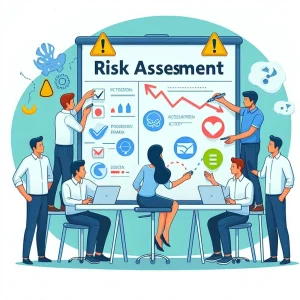Introduction to SOC 2 and Exceptions
Understanding the significance of SOC 2 compliance is crucial for organizations that handle sensitive data. SOC 2, or Service Organization Control 2, is a framework developed by the American Institute of CPAs (AICPA) that evaluates the effectiveness of a service organization’s controls related to security, availability, processing integrity, confidentiality, and privacy. This framework is particularly important for service providers that store customer data in the cloud, as it helps build trust with clients by demonstrating a commitment to maintaining high standards of data protection and security.
Importance of SOC 2 in Internal Audits
SOC 2 compliance is not just a regulatory requirement; it serves as a benchmark for organizations to assess their internal controls and risk management practices. A successful SOC 2 audit can enhance an organization’s reputation, foster client trust, and potentially lead to new business opportunities. Moreover, it highlights any gaps in security that need addressing, thereby reinforcing the organization’s overall security posture and compliance efforts [10].
Understanding SOC 2 Exceptions
Exceptions in the context of SOC 2 audits refer to instances where a service organization fails to meet one or more of the established criteria. These exceptions can arise from deficiencies in the design or operational effectiveness of controls, which may be due to various factors such as inadequate training, insufficient resources, or poorly planned processes [8][9]. It is essential to recognize that exceptions are a common part of the auditing process and do not necessarily indicate a failure of the entire compliance effort. Instead, they provide valuable insights into areas that require improvement [4].
Implications of SOC 2 Exceptions on Compliance and Organizational Risk
The presence of SOC 2 exceptions can have significant implications for an organization. Firstly, they can raise red flags for clients and stakeholders, prompting them to reconsider their partnerships if they perceive a lack of commitment to security [10]. Additionally, exceptions can expose the organization to increased risk, as they may indicate vulnerabilities in the control environment that could be exploited by malicious actors. Therefore, it is vital for organizations to address these exceptions promptly and effectively to mitigate potential risks and maintain compliance with SOC 2 standards [4][12].
Understanding the Types of SOC 2 Exceptions
It is crucial to understand the various types of exceptions that can arise. These exceptions can significantly impact the audit process and the overall compliance posture of an organization. Below, we categorize and clarify the different types of SOC 2 exceptions, providing real-world examples and discussing their implications.
1. Types of SOC 2 Exceptions
SOC 2 exceptions can generally be categorized into two main types: control deficiencies and deviations. Each of these categories can further influence the audit outcomes and compliance status.
- Control Deficiencies: This type of exception occurs when a control is in place but fails to operate effectively. For instance, if an organization has a control in place for monitoring access logs but does not review these logs for a specific period, this would be classified as a control deficiency. Such deficiencies can lead to vulnerabilities in the system, potentially exposing sensitive data to unauthorized access [7].
- Deviations: Deviations refer to instances where the established controls are not followed as intended. For example, if a company has a policy requiring quarterly security training for employees but fails to conduct the training for a specific quarter, this would be a deviation from the expected control. Deviations can indicate a lack of adherence to compliance protocols, which can undermine the integrity of the audit process [7].
2. SOC 2 Type I vs. Type II Exceptions
Understanding the differences between SOC 2 Type I and Type II audits is essential, as they can lead to different types of exceptions:
- SOC 2 Type I: This audit assesses the design of security processes at a specific point in time. An exception in a Type I audit might occur if the controls are not adequately designed to meet the Trust Services Criteria. For example, if a company’s access control system is found to have inadequate user authentication measures at the time of the audit, this would be a significant exception [11].
- SOC 2 Type II: In contrast, a Type II audit evaluates not only the design but also the operational effectiveness of controls over a specified period. An exception in this context could arise if a control that was initially well-designed fails to operate effectively over time. For instance, if a company implements a data encryption control but fails to apply it consistently across all data transfers during the audit period, this would be classified as a Type II exception [15].
3. Impact of SOC 2 Exceptions on the Audit Process and Compliance
The presence of SOC 2 exceptions can have profound implications for both the audit process and the organization’s compliance status:
- Audit Process: Exceptions can complicate the audit process, requiring additional time and resources to address identified gaps. Auditors may need to conduct follow-up assessments or recommend corrective actions, which can delay the final audit report and increase costs [5].
- Overall Compliance: The impact on compliance can be significant. Control deficiencies and deviations can lead to non-compliance with the Trust Services Criteria, which may result in adverse audit opinions. For example, if a service organization receives an adverse opinion due to multiple exceptions, it may need to undertake corrective actions and potentially undergo another audit to demonstrate compliance [3][5].
Step 1: Identifying SOC 2 Exceptions
Identifying SOC 2 exceptions is a critical first step in the internal audit process, as it sets the foundation for addressing compliance issues effectively. Here’s a detailed approach to help internal auditors and compliance specialists in this essential phase.
Methodologies for Identifying Exceptions
- Walkthroughs: Conducting walkthroughs involves tracing a transaction from initiation to completion. This method allows auditors to observe processes in real-time, ensuring that controls are functioning as intended. During walkthroughs, auditors can identify any deviations from established procedures that may indicate exceptions.
- Testing Controls: This involves evaluating the effectiveness of controls by testing them against predefined criteria. Auditors should select a sample of transactions and assess whether the controls were applied correctly. This testing can reveal exceptions where controls failed to operate as expected, providing insight into potential vulnerabilities.
- Interviews and Surveys: Engaging with personnel involved in the processes can uncover insights about control effectiveness and areas where exceptions may occur. Surveys can also be used to gather information on compliance awareness and adherence among staff.
Importance of Documentation and Evidence Collection
- Comprehensive Documentation: Maintaining thorough documentation is vital for substantiating findings during the audit. This includes recording the methodologies used, the scope of testing, and the results obtained. Proper documentation not only supports the identification of exceptions but also serves as a reference for future audits.
- Evidence Collection: Collecting evidence is crucial for validating the existence of exceptions. This can include screenshots, logs, reports, and other relevant data that demonstrate where controls may have failed. Evidence should be organized systematically to facilitate review and analysis.
Tips on Using Technology and Tools for Exception Identification
- Audit Management Software: Utilizing specialized audit management tools can streamline the process of identifying exceptions. These tools often include features for tracking findings, managing documentation, and automating testing procedures, which can enhance efficiency and accuracy.
- Data Analytics: Leveraging data analytics can help auditors identify patterns and anomalies that may indicate exceptions. By analyzing large datasets, auditors can pinpoint areas of concern that may not be immediately visible through traditional methods.
- Continuous Monitoring Tools: Implementing continuous monitoring solutions can provide real-time insights into control effectiveness. These tools can alert auditors to potential exceptions as they occur, allowing for timely intervention and remediation.
By employing these methodologies, emphasizing the importance of documentation, and utilizing technology effectively, internal auditors can enhance their ability to identify SOC 2 exceptions. This proactive approach not only aids in compliance but also strengthens the overall control environment within the organization.
Step 2: Analyzing the Impact of Exceptions
Addressing exceptions is crucial for maintaining compliance and ensuring the integrity of internal controls. This section focuses on evaluating the impact of identified exceptions, which is essential for internal auditors and compliance specialists to prioritize their remediation efforts effectively.
Evaluating the Impact of Exceptions
- Assessing Internal Controls:
- Business Operations Implications:
- Analyze how exceptions may impact business operations. For instance, an exception related to data security could expose sensitive customer information, leading to reputational damage and financial loss [10].
Risk Assessment Techniques
- Prioritizing Exceptions:
- Utilize risk assessment techniques to prioritize exceptions based on their potential impact and likelihood of occurrence. This involves categorizing exceptions into high, medium, and low-risk levels, allowing auditors to focus on the most critical issues first [12].
- Consider factors such as the nature of the exception, the volume of transactions affected, and the sensitivity of the data involved. High-risk exceptions should be addressed immediately, while lower-risk issues can be scheduled for later remediation [12].
- Engaging Stakeholders:
- Collaborate with relevant stakeholders, including IT, compliance, and operational teams, to gather insights on the implications of exceptions. This collaborative approach ensures a comprehensive understanding of the risks associated with each exception and aids in developing effective remediation strategies [4][10].
Framework for Classifying Exceptions
- Risk Levels Classification:
- Develop a framework for classifying exceptions based on their risk levels. This framework should include criteria such as:
Severity: The extent to which the exception affects compliance with SOC 2 criteria.
Frequency: How often the exception occurs or is likely to occur.
Impact: The potential consequences for the organization, including financial, operational, and reputational risks [12][13].
- By categorizing exceptions in this manner, auditors can create a prioritized action plan that addresses the most significant risks first, ensuring that resources are allocated efficiently [12].
- Develop a framework for classifying exceptions based on their risk levels. This framework should include criteria such as:
- Documentation and Reporting:
By categorizing exceptions in this manner, auditors can create a prioritized action plan that addresses the most significant risks first, ensuring that resources are allocated efficiently [12].
Step 3: Communicating Exceptions to Stakeholders
When addressing SOC 2 exceptions during internal audits, effective communication with stakeholders is crucial. Clear and transparent reporting not only fosters trust but also ensures that all parties are informed and engaged in the remediation process. Here are some best practices and examples to guide internal auditors and compliance specialists in communicating exceptions effectively.
Best Practices for Reporting Exceptions
- Be Proactive: As soon as an exception is identified, communicate it to relevant stakeholders. Delaying communication can lead to misunderstandings and a lack of trust. Transparency is key, as it demonstrates a commitment to security and compliance [3].
- Use Clear Language: Avoid jargon and technical terms that may confuse non-technical stakeholders. Instead, use straightforward language to describe the exception, its implications, and the steps being taken to address it [3].
- Detail the Nature of the Exception: Clearly outline what the exception is, why it occurred, and how it affects the organization. This includes specifying whether it is a major or minor exception, as major exceptions may require more immediate attention and resources [6].
- Outline the Remediation Plan: Provide a clear plan for how the organization intends to address the exception. This should include timelines, responsible parties, and any resources needed for remediation. Stakeholders should feel confident that there is a structured approach to resolving the issue [3][12].
- Regular Updates: Keep stakeholders informed throughout the remediation process. Regular updates can help maintain trust and ensure that everyone is aware of progress and any changes to the plan [3].
Importance of Transparency and Clarity
Transparency in communication regarding SOC 2 exceptions is vital for several reasons:
- Builds Trust: When stakeholders are kept in the loop about exceptions and remediation efforts, it builds trust in the organization’s commitment to security and compliance. This is particularly important for clients and partners who rely on the organization’s integrity [1].
- Encourages Collaboration: Clear communication fosters a collaborative environment where stakeholders can contribute to the remediation process. This can lead to more effective solutions and a stronger overall security posture [10].
- Mitigates Risks: By being transparent about exceptions, organizations can better manage risks associated with non-compliance. Stakeholders are more likely to support necessary changes when they understand the potential implications of the exceptions [2].
Example Template for Exception Communication
Subject: SOC 2 Exception Notification
To: [Stakeholder Names/Departments]
From: [Your Name/Department]
Date: [Insert Date]
Dear [Stakeholder Names],
I am writing to inform you of a SOC 2 exception identified during our recent internal audit.
Exception Details:
– Nature of Exception: [Brief description of the exception]
– Date Identified: [Insert date]
– Impact: [Explain how this exception affects the organization]
Remediation Plan:
– Action Steps: [List the steps that will be taken to address the exception]
– Responsible Parties: [Identify who will be responsible for each action]
– Timeline: [Provide an estimated timeline for remediation]
We are committed to resolving this issue promptly and will keep you updated on our progress. Please feel free to reach out if you have any questions or require further information.
Thank you for your understanding and support.
Best regards,
[Your Name]
[Your Position]
[Your Contact Information]
By following these best practices and utilizing effective communication templates, internal auditors can ensure that SOC 2 exceptions are addressed in a manner that promotes transparency, trust, and collaboration among stakeholders. This approach not only aids in compliance but also strengthens the organization’s overall security framework [3][10].
Step 4: Developing Remediation Plans
Addressing SOC 2 exceptions is a critical component of the internal audit process, ensuring that organizations maintain compliance with the Trust Services Criteria. Developing effective remediation plans is essential for rectifying identified exceptions and preventing future occurrences. Here’s a detailed approach to formulating actionable remediation plans.
Formulating Actionable Remediation Plans
- Identify Specific Exceptions: Begin by clearly documenting each SOC 2 exception identified during the audit. This includes detailing the nature of the exception, the associated risks, and the specific controls that were found lacking. Comprehensive documentation is crucial as it serves as the foundation for your remediation efforts [4].
- Analyze Root Causes: For each exception, conduct a root cause analysis to understand why the deviation occurred. This may involve reviewing processes, policies, and control designs. Understanding the underlying issues will help in crafting targeted remediation strategies that address not just the symptoms but the causes of the exceptions [5].
- Develop Targeted Remediation Strategies: Create specific strategies tailored to each exception. This could involve:
- Policy Updates: Revising existing policies to align with compliance requirements.
- Control Enhancements: Implementing stronger controls or improving existing ones to mitigate risks.
- Training Programs: Developing training sessions for staff to ensure they understand compliance requirements and their roles in maintaining them [12].
Setting Timelines and Responsibilities
- Establish Clear Timelines: Assign realistic deadlines for each remediation action. Timelines should be based on the severity of the exception and the complexity of the remediation required. This helps in prioritizing actions and ensuring timely resolution [10].
- Assign Responsibilities: Clearly define who is responsible for each remediation task. This could involve designating specific team members or departments to oversee the implementation of the remediation strategies. Accountability is key to ensuring that actions are taken and that there is follow-through on commitments [11].
- Monitor Progress: Implement a tracking system to monitor the progress of remediation efforts. Regular check-ins can help ensure that timelines are being met and that any obstacles are addressed promptly. This ongoing monitoring is essential for maintaining compliance over time [15].
By following these steps and focusing on actionable remediation plans, internal auditors and compliance specialists can effectively address SOC 2 exceptions, thereby enhancing the organization’s compliance framework and reducing the risk of future deviations.
Step 5: Monitoring and Follow-Up
Addressing SOC 2 exceptions is not a one-time effort; it requires a commitment to ongoing monitoring and follow-up to ensure that remediation plans are effective and that internal controls are continuously improved. Here are key methods and practices for internal auditors and compliance specialists to consider:
Tracking Progress of Remediation Plans
- Establish Clear Metrics: Define specific, measurable criteria to evaluate the effectiveness of remediation efforts. This could include timelines for completion, the number of exceptions resolved, and the effectiveness of implemented controls. Regularly review these metrics to assess progress and make necessary adjustments [1].
- Utilize Project Management Tools: Implement project management software to track the status of remediation activities. These tools can help assign responsibilities, set deadlines, and provide visibility into the progress of each remediation task. This ensures accountability and facilitates communication among team members [2].
- Regular Status Meetings: Schedule periodic meetings with relevant stakeholders to discuss the status of remediation efforts. These meetings can serve as a platform for addressing challenges, sharing updates, and ensuring that everyone is aligned on the remediation goals [2].
Conducting Follow-Up Audits
- Plan Follow-Up Audits: After remediation plans have been implemented, conduct follow-up audits to verify that exceptions have been effectively resolved. These audits should focus on the specific areas where exceptions were noted and assess whether the corrective actions taken are functioning as intended [3].
- Document Findings: During follow-up audits, meticulously document findings and compare them against the original exceptions. This documentation will provide a clear record of whether the remediation efforts were successful and will help identify any lingering issues that need further attention [4].
- Engage Stakeholders: Involve key stakeholders in the follow-up audit process to ensure that they understand the importance of addressing exceptions and are committed to maintaining compliance. Their engagement can foster a culture of accountability and continuous improvement within the organization [4].
Continuous Improvement in Internal Controls
- Feedback Loop: Establish a feedback mechanism to learn from the remediation process. Gather insights from the follow-up audits and stakeholder discussions to identify areas for improvement in internal controls. This feedback loop is essential for refining processes and preventing future exceptions [1][3].
- Training and Awareness: Regularly train staff on the importance of SOC 2 compliance and the role of internal controls in mitigating risks. Increased awareness can lead to better adherence to policies and procedures, ultimately reducing the likelihood of future exceptions [2].
- Review and Update Policies: Periodically review and update internal policies and procedures to reflect lessons learned from the remediation process. This proactive approach ensures that the organization remains agile and responsive to changing compliance requirements and risks [4].
Conclusion and Best Practices
Addressing SOC 2 exceptions is a critical component of internal audits, as it directly impacts an organization’s ability to maintain compliance and uphold trust with clients and stakeholders. By effectively managing these exceptions, organizations can not only rectify current issues but also strengthen their overall security posture and operational efficiency. Here are some key points to consider:
- Importance of Addressing SOC 2 Exceptions: SOC 2 audits are designed to ensure that service organizations manage data securely to protect the privacy of their clients. When exceptions arise, they can indicate vulnerabilities in the control environment that need immediate attention. Failing to address these exceptions can lead to significant risks, including data breaches and loss of client trust, which can have long-term repercussions for the organization [10][11].
- Encouraging a Proactive Approach: A proactive stance on exception management is essential. Organizations should not wait for the annual audit to identify and address potential issues. Instead, regular internal audits should be conducted to catch deviations from compliance requirements early. This approach allows for timely remediation and helps maintain a culture of continuous improvement within the organization [14][15].
Best Practices for Maintaining SOC 2 Compliance
To effectively manage SOC 2 exceptions and ensure ongoing compliance, consider implementing the following best practices:
- Regular Internal Audits: Conduct periodic internal audits to identify any gaps or weaknesses in controls. This proactive measure helps organizations uncover potential issues before they escalate into significant exceptions [15].
- Collaborate with Service Auditors: Work closely with your service auditor to understand the expectations and requirements of the SOC 2 audit process. This collaboration can provide valuable insights into areas that may require additional focus [3].
- Identify and Mitigate Risks: Develop a comprehensive risk management strategy that includes identifying risk-mitigating practices. This strategy should be dynamic and adaptable to changes in the operational environment [3].
- Promptly Resolve Control Exceptions: Prioritize the resolution of control exceptions as they arise. Tracking progress and ensuring timely remediation is crucial for maintaining compliance and demonstrating a commitment to security [4].
- Utilize Auditor Feedback: After the audit, be responsive to feedback and ready to make necessary adjustments. Use the findings as a roadmap for strengthening your security posture and enhancing compliance efforts [5][6].
- Document Policies and Procedures: Establish and document clear policies that align with industry best practices. This documentation should be regularly reviewed and updated to reflect any changes in the operational landscape or compliance requirements [13].
By adopting these best practices and fostering a proactive approach to exception management, internal auditors and compliance specialists can significantly enhance their organization’s ability to navigate the complexities of SOC 2 compliance. This not only helps in addressing current exceptions but also lays a solid foundation for future audits and compliance efforts.
Find out more about Shaun Stoltz https://www.shaunstoltz.com/about/
This post was written by an AI and reviewed/edited by a human.



